Expedition to the ancestors. Downstream and upstream

Still from the movie “Pharaoh” (1963). For the filming of just one small episode, a real “Egyptian ship” was built. It is clear that it is a prop, but very reliable in appearance. The filmmakers did their best, needless to say
23 Kings 35:XNUMX
Migrants and migrations. So, we return again to the topic of ancient migrations and, accordingly, migrants who in ancient times moved here and there, which contributed to the spread of the achievements of civilization, language and culture as a whole.
In the last previous material of this series, we focused on the predynastic period stories Ancient Egypt (end of the 3100th millennium - ca. 3400 BC), which became the time of the final decomposition of tribal relations on its territory (until the middle of the XNUMXth millennium). At the same time, the formation of a socially differentiated society took place, and the first ancient Egyptian states arose (second half of the XNUMXth millennium). At the same time, writing also appeared, and the earliest written monuments that have reached us date back to approximately XNUMX BC. e.
In turn, the Predynastic period is divided into two large subperiods - Amratian (Negada I culture) and Gerzean (Negada II, c. 3100 BC). This period ended with the beginning of the reign of the so-called zero dynasty (Negada III) - that is, the time when Upper and Lower Egypt came close to uniting into one state, which is believed to have happened under Pharaoh Narmer.

The same film shows how Prince Ramses hunts in the reeds from a papyrus boat. Well, maybe not papyrus, but outwardly it is indistinguishable from the boats in ancient Egyptian images
Let us remember that by the middle of the 5th millennium, the Tasian and Badarian cultures of the Chalcolithic era, that is, the Copper-Stone Age, existed in Upper Egypt. The Thasians were farmers and pastoralists, but hunting and fishing supplied them with the main amount of food. However, it was not difficult for them to fish and hunt. There were a lot of fish in the Nile, and myriads of birds nested in the reed thickets along its banks. It is believed that they were the first to irrigate the lands and dig the first canals to drain water from the Nile. The Badaris raised not only small cattle, but also cattle, and stored their crops in specially built granaries. And it was they who were the first in Egypt to domesticate the cat (or the cat itself came to them!) in order to protect their grain reserves from rodents. Another important achievement of the Badarians was the ability to smelt copper, which was mined on the Sinai Peninsula.
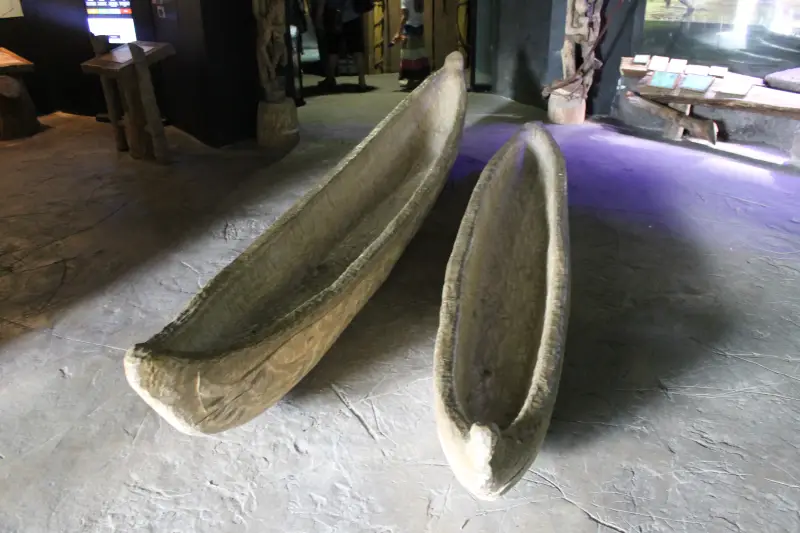
There was no “forest” as such in Egypt. That’s why there weren’t such dugout boats. Exposition of the zoo in Prague. Author's photo
In Lower Egypt, around the same time, there existed the Fayum Neolithic culture, also farmers and pastoralists, distinguished by the production of rough molded pottery.
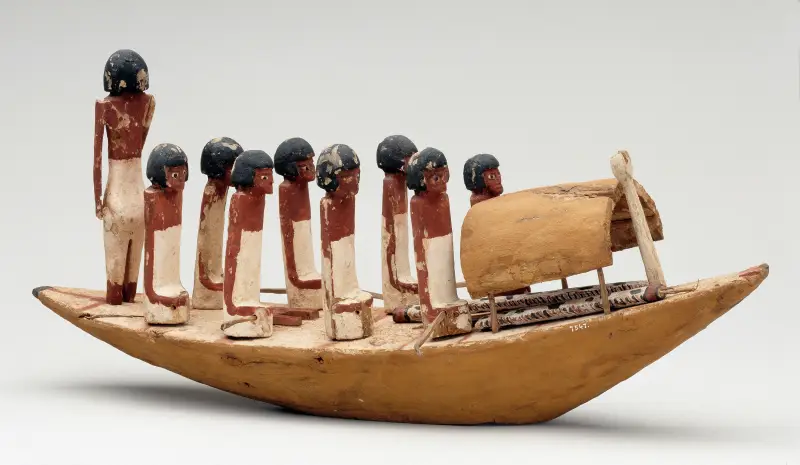
Ancient Egyptian Nile ship. National Museum of Denmark, Copenhagen
And here it should be noted that a number of completely unique circumstances contributed to the interpenetration and fusion of all these cultures. Thus, the beginning of the predynastic period coincided in time with the Neolithic subpluvial - that is, the era when the entire Sahara was covered with greenery. But very soon the climate became arid, and deserts spread over Egypt from all sides.
In general, the Egyptians are very lucky with the climate. From the Mediterranean Sea, a light breeze usually blew along the Nile bed. It reduced the heat and... allowed ships to sail up the Nile without resorting to the services of rowers!
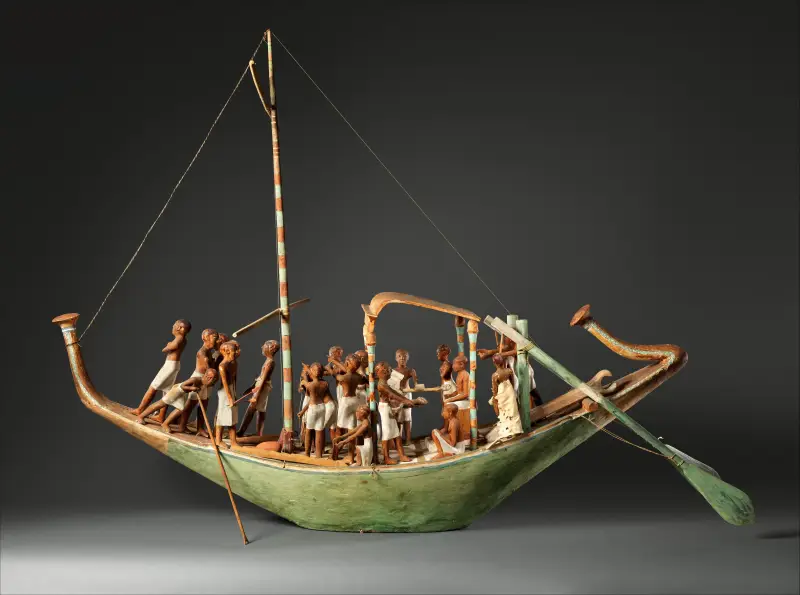
Model of a ship from the tomb of Meketre. The green hull of this boat, its vertical bow, curved stern and double steering oars imitate the design of ships made from papyrus stems. Even the straps of the leather covers that covered the bow and stern of such boats are visualized. Boats of this type appear in depictions of the "pilgrimage to Abydos", which was part of Egyptian funerary ritual beginning in the Middle Kingdom. The ritual nature of the voyage is demonstrated by the fact that under the canopy sits not a living Meketre, but a statue of him, accompanied by a companion (possibly his son), and there is also a large vessel for libations. But the main idea of sailing to the cult center of the god Osiris at Abydos, where the death and resurrection of the god was celebrated, was achieved by using two boats: one that sailed north from Thebes to Abydos against the wind, and one that set off on the return journey under sail. Date: approx. 1981-1975 BC e. Upper Egypt, Thebes, Southern Asasif, Meketre's tomb. Excavations in 1920. Materials: wood, paint, plaster, linen twine, linen fabric. Dimensions: length 132,5 cm, with steering oar 138,5 cm; height 53 cm; width 38 cm. Metropolitan Museum of Art, New York
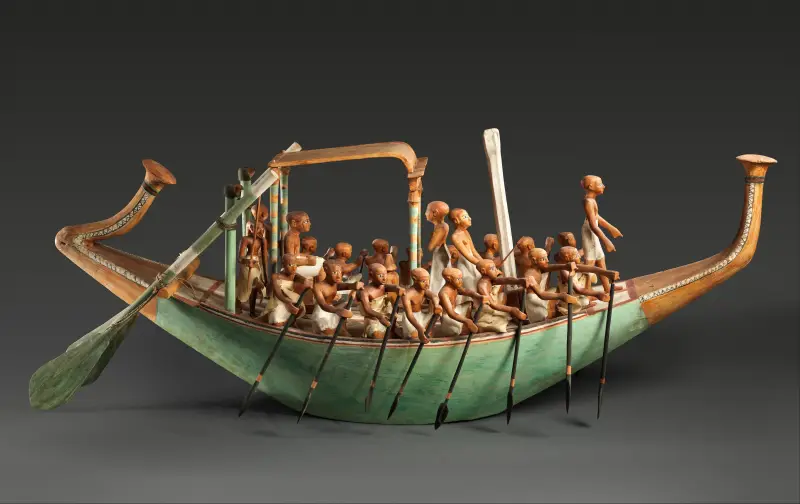
The second boat... It has rowers working on it, which means it is sailing north to Abydos. There were also two hieroglyphs in Egyptian writing: a boat with a sail - “upstream” and without a sail - downstream!
In the middle of the 4th millennium, the Amrat culture was replaced by the Gerzean culture. The role of irrigation has increased, but yields have also increased. Crafts began to be separated from agriculture, and the differentiation of society accelerated sharply. Copper axes, daggers, knives, arrowheads, vessels and even toilet spoons are found in the burials. Trade is developing. For example, even lapis lazuli from Afghanistan is imported from Asian countries to Egypt. The population of the Delta conducts active trade with Mesopotamia, as evidenced by the characteristic cylinder seals found here.
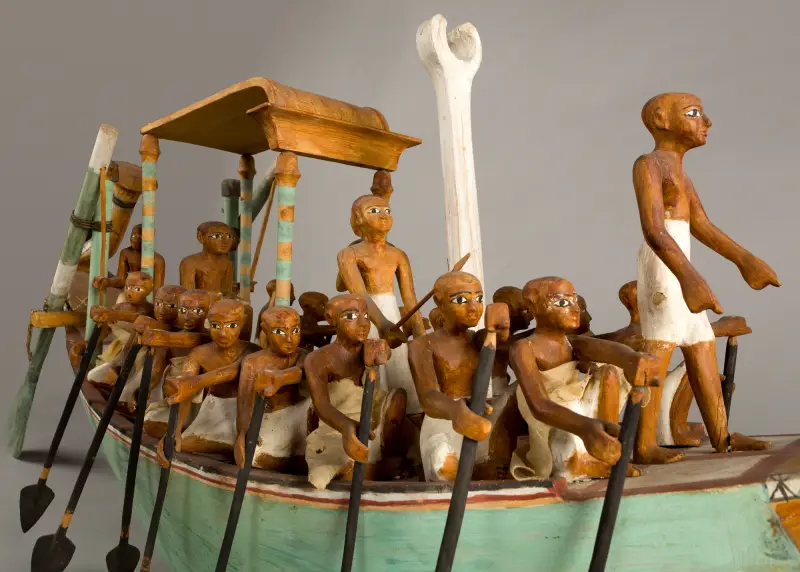
Look how lifelike the faces of the rowing figures are...
Wealth inequality is now glaringly obvious. And the rich burials of the leaders speak about him. The institution of slavery emerges. And this is not surprising. The benefits of irrigation became obvious to everyone. The large scale of irrigation work required workers and the creation of a state with appropriate control and management functions. At first these were nomes - small associations of just a few settlements around a larger city, where the temple of the main deity and the residence of the local ruler were located.
By the way, there were many nomes in Egypt. How many in the era of the formation of the state is unknown. But during the era of the New Kingdom there were 20 of them in Lower Egypt, and 22 in Upper Egypt. Moreover, in Upper Egypt a state was formed earlier than in Lower Egypt. The capital of the state in Upper Egypt was in the city of Nekhen. The capital of Nizhny is Buto.
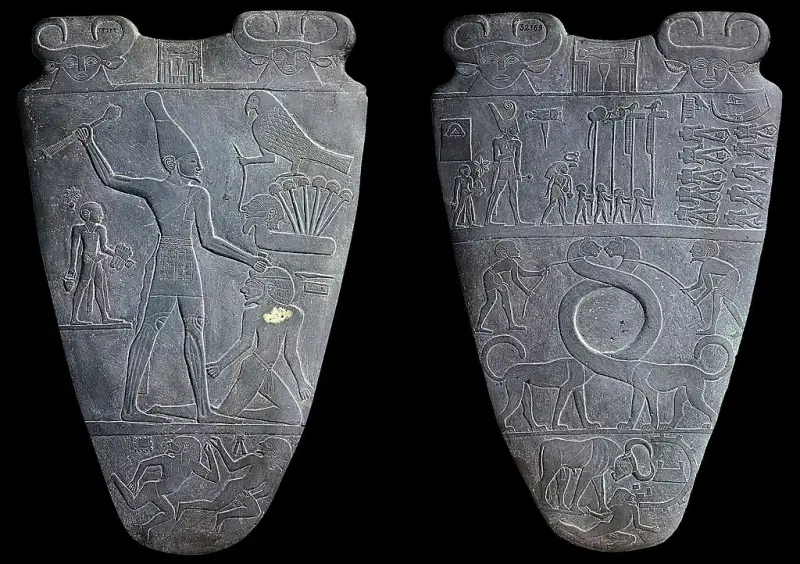
The famous "Narmer palette". It is considered a gift from the king of the First or Zero Dynasty to the Hierakonpolis Temple, which perpetuated his victory over the rebellious Libyan nomes in the Western Nile Delta. Historians have suggested that it depicts the victory of Narmer's army over the city of Wash. Here Narmer is depicted wearing two crowns: the white (hedjet) crown of Upper Egypt and the red (deshret) crown of Lower Egypt. Egyptian Museum in Cairo
And it was impossible without a state in Egypt, since complex irrigation and maintaining the canal system in order required centralized management and an entire army of officials, which happened during the period of dominance of the Negad III culture in Egypt. As happened most often in ancient times, the question of who won whom was decided by a war in which the more developed South defeated the swampier one (at that time, as many as eight branches flowed into the Mediterranean through the Nile Delta, now there are only two!) and therefore less rich in resources North. The winner of this war was Pharaoh Menes (Mina or Min), who founded the First Royal Dynasty, although it is known that before it there was also the Zero Dynasty, whose pharaohs were at enmity with each other. In any case, we know the names of some of them. And we know that they were not relatives.
However, there is also an opinion that it was not Menes, but Narmer who carried out the unification of Egypt, as indicated by the “Narmer palette” apparently found in 1898, on which he is depicted in one case wearing the crown of Upper Egypt, and in another – Lower Egypt!
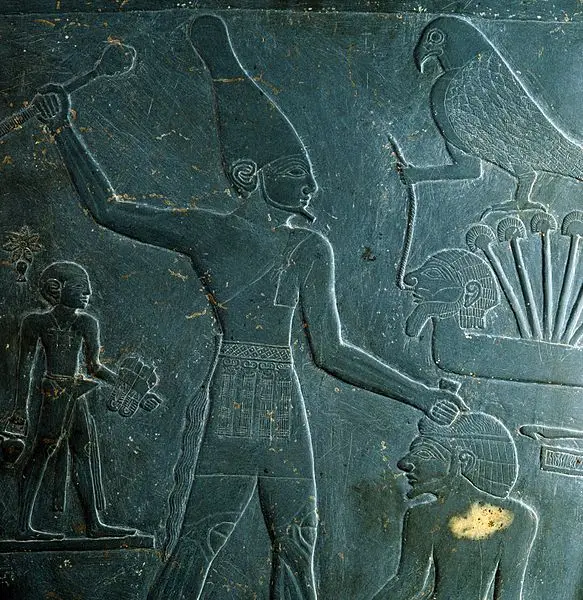
Narmer in a high white crown - the hedjet - the crown of Upper Egypt, hits his opponent on the head with a mace, judging by the wig - also an Egyptian
In any case, around 3100 the Predynastic Period came to an end, as did the Zero Dynasty, and the so-called Old Kingdom began in Egypt.
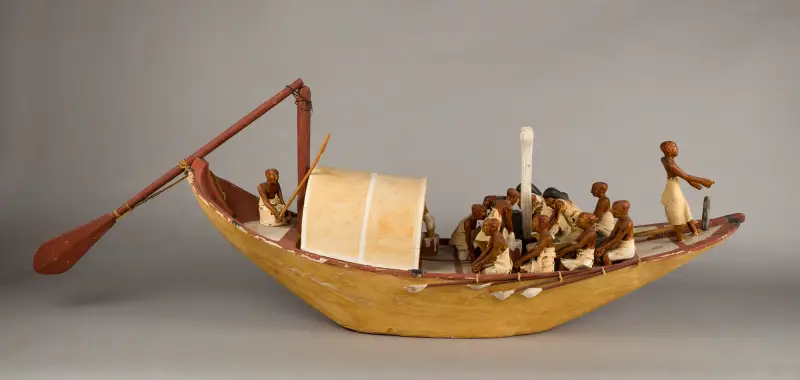
Like us today, the Egyptians loved picnics, especially the nobility. The menu for the Meketra boat trip included fried poultry, beef jerky, bread, beer and some kind of soup. That is, before us is nothing more than... a floating kitchen, in which food is being prepared for the Egyptians who are camping somewhere on a picnic during the voyage. Meat and bread were transported on another model, which is located in the Cairo Museum. Beer and soup are also brewed here. The blackened trough may have contained burning charcoal for roasting poultry. A man watches the stove on which soup is boiling. A woman grinds grain. Brewers inside the cabin form loaves of bread and then press them through sieves into large vats. One brewer stands in a vat and tramples dates, which provide sugar for the fermentation of beer. The oars of this boat are attached to the sides. To avoid damage to the oars during transport and storage of the boats in the model chamber, all the oars of the boats in the tomb of Meketre were secured in a similar way. OK. 1981-1975 BC e. Tomb of Meketre. Metropolitan Museum of Art, New York
And it should be noted that, to a large extent, the prosperity of the ancient Egyptian state, including the times of Roman rule, was connected precisely with the Nile. We have already discussed its role in providing the Egyptians with food in one of the articles in this series. But now it is important to point out another circumstance - the Nile was also an excellent transport artery, connecting the north with the south year-round. And here, along the banks of the Nile, the building material from which the main part of the Egyptian river ships was built - papyrus - grew.

Very lively poses, although the figures themselves are a little rough...
From drawings on the walls of tombs we know that already in ancient times the Egyptians used boats assembled from bundles of papyrus. It is clear that these vessels were small and more reminiscent of spindle-shaped rafts. However, even on such boats it was possible to cross the Nile, hunt in the reed beds and fish. The Egyptians could not build large ships from scrap materials, since there was no suitable wood for this in Egypt.
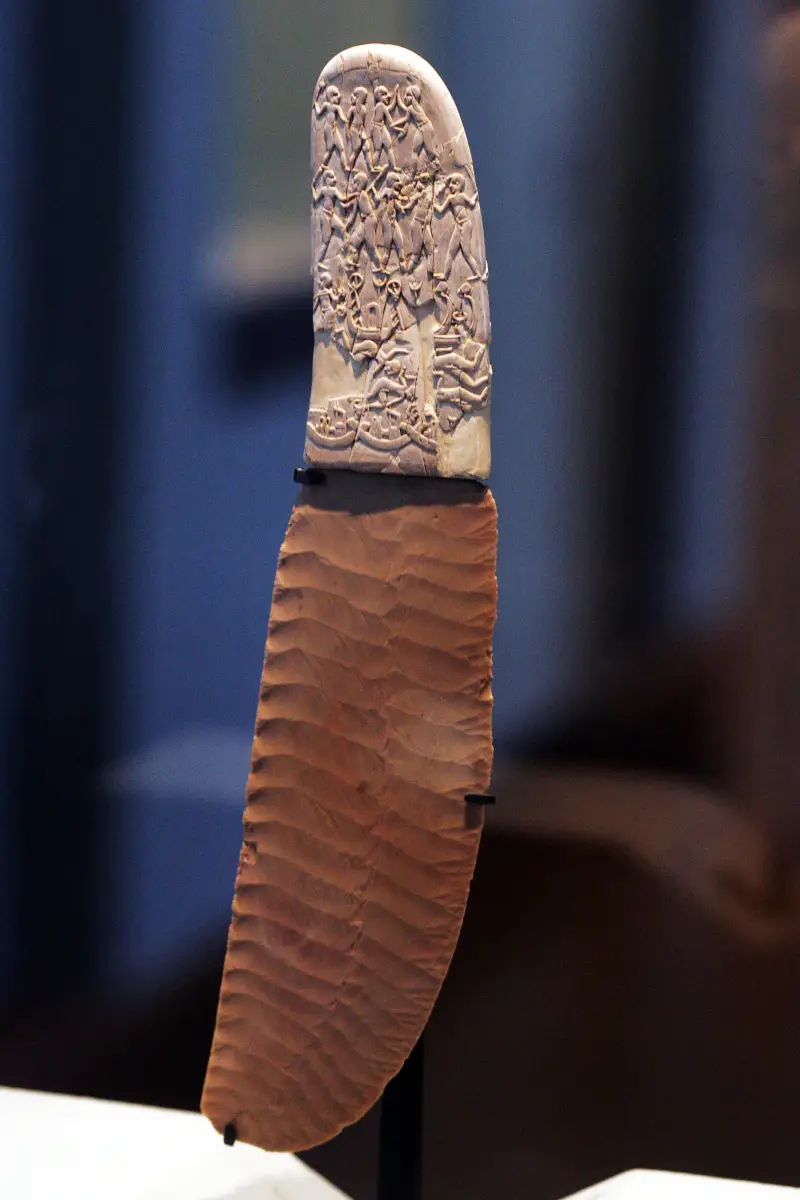
Flint knife from Gebel el-Arak with a carved handle. Cultural monument of Negada II or Negada III. The knife handle is made of ivory. Length 9,5 cm, width at the base - 4,2 cm. This is the most valuable part of the knife, as it has images engraved on both sides. On one side there is a battle scene - naked warriors at the top, and at the bottom there is a scene with boats, which can be interpreted as a battle on the water (on a river or even the sea). On the other side of the image is clearly symbolic - a man along with two lions, dogs and other animals. The warriors are armed with flint knives, clubs, and pear-shaped maces. It is believed that they came to Egypt from Mesopotamia and replaced the traditional Egyptian disk-shaped mace. There is speculation that the relief depicts a battle between warriors from the cities of Abydos and Hierakonpolis, the two main rival Egyptian cities of the period. Abydos won, so that in fact most of Egypt was united under the rule of rulers from Abydos precisely during the period of Negad III. Louvre
But with the unification of the country, Egypt began to receive large-sized boards from Lebanon, where the famous Lebanese cedars grew. Smaller boats began to be built from local palm wood. So the total “tonnage” of the ancient Egyptian river fleet very quickly became exceptionally large. During the reign of the pharaohs - the builders of the pyramids, ships began to be used to transport stone blocks, and, accordingly, their size and carrying capacity increased even more.
To be continued ...
Information